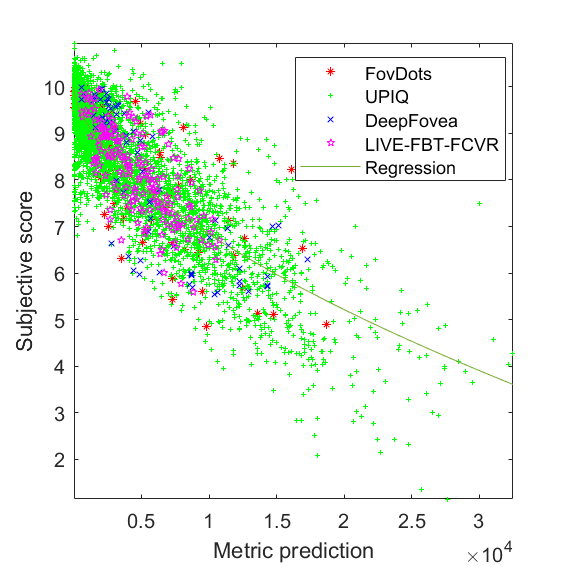Both temporal channels
RMSE = 0.8123 PLCC = 0.8554 SROCC = 0.8287 JOD regression: Q = 10 -0.0129523 * M^0.596953
JOD regression: Q = 10 -0.0129523 * M^0.596953

| Metric/Variant | RMSE | PLCC | SROCC | ||||||||||||
| FovDots | UPIQ | DeepFovea | LIVE-FBT-FCVR | Average(1) | FovDots | UPIQ | DeepFovea | LIVE-FBT-FCVR | Average(2) | FovDots | UPIQ | DeepFovea | LIVE-FBT-FCVR | Average(3) | |
| Both temporal channels → | 0.8938 | 0.7696 | 0.9376 | 0.6481 | 0.8123 | 0.7873 | 0.8599 | 0.8322 | 0.728 | 0.8554 | 0.8148 | 0.83 | 0.8413 | 0.7254 | 0.8287 |
| Only sustained channel → | 1.143 | 0.7713 | 0.9561 | 0.616 | 0.8717 | 0.7298 | 0.8589 | 0.8449 | 0.7534 | 0.8526 | 0.7355 | 0.8272 | 0.8477 | 0.7534 | 0.8246 |
(1)Average RMSE is computed as an average of RMSEs of individual datasets so that each dataset has the same influence on the average RMSE regardless of the number of conditions it contains.
(2-3)Average correlation coeffcients are computed for the consolidated dataset consisting of all four individual datasets. It means that the average correlation coefficients are dominated by the performance of UPIQ, which contains over 4000 conditions. For that reason, RMSE is more indicative of metric performance.